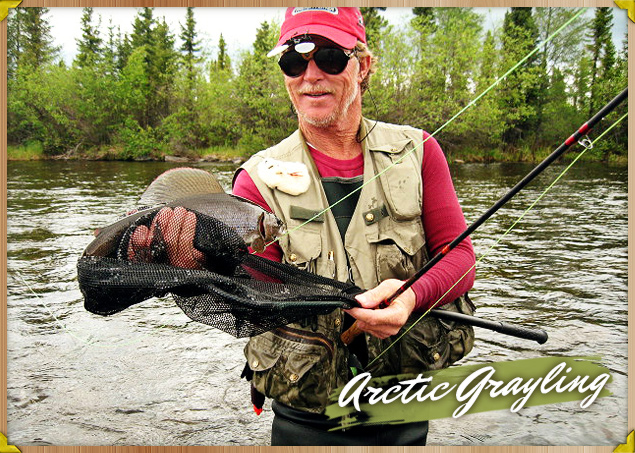


Images: 1 2 3 4 5
all about Arctic grayling
The species is native to the Nearctic and Palearctic ecozones. T. a. arcticus is widespread throughout the Arctic and Pacific drainages in Canada, Alaska, and Siberia, as well as the upper Missouri River drainage in Montana. The other subspecies have narrower ranges.
For most sport fishers in America, the Arctic grayling (Thymallus arcticus (Pallus) is a rare freshwater game fish symbolic of the clear, cold streams of the northern wilderness. Grayling occur throughout the arctic as far west as the Kara and Ob rivers in Russia and east to the western shores of Hudson Bay in Canada. Once as common as far south as Michigan and Montana, the Arctic grayling has almost disappeared from the northern United States because of overfishing, competition from introduced species, and habitat loss.
The Arctic Grayling grows to a maximum recorded length of 76 cm (30 inches).
The hooked pike fight in the depths rather than leaping from the water. As a sport fish, it is usually taken by trolling with large spoons, plugs or large bait fish.
Arctic Grayling. the Name
- T. arcticus arcticus. The Binomial name is Thymallus arcticus.
- The Arctic grayling (Thymallus arcticus) is a species of freshwater fish in the salmon family (family Salmonidae) of order Salmoniformes. It comprises five subspecies.
Description
- Length
Grows to a maximum recorded length of 76 cm (30 inches) and a maximum recorded weight of 3.8 kg (8.4 pounds). - Weight
Has maximum weights of about 1 to 1.3 kg (2 to 3 pounds). - Color
- The Arctic Grayling is darker in colour.
- There is a dark midlateral band between the pectoral and pelvic fins, and the flanks may possess a pink iridescence. Some subspecies exhibit distinctive coloration.
- Body
The grayling has two wide vertical bars of lighter shade along its body.
- Lifespan
The Arctic Grayling has been recorded as reaching an age of 18 years.
Habitat
- During the Ice Age, Arctic grayling survived in unglaciated areas of Alaska in the Yukon River valley and the North Slope. From there, they have spread throughout Alaska, except Kodiak, Southeast Alaska, and the Aleutians.
- The Arctic grayling occurs primarily in cold waters of mid-sized to large rivers and lakes, returning to rocky streams to breed, although T. a. baicalensis remains in shallow waters for its entire life. The various subspecies are omnivorous.
Food
- Grayling are generalists in their food habits, but drifting aquatic insects, especially mayflies, stone flies, and caddis flies are their primary food items. At times Arctic grayling will gorge upon the eggs of spawning salmon, outmigrating salmon smolts, terrestrial insects that have fallen into the water, or even an occasional vole or shrew!
catch and release
We have implement the catch and release program. We measured and photograph then release our catch. We handle the Arctic Grayling with the upmost care. Care is required in unhooking a grayling. It is recommended that barbless trebles are used when angling for this species as it simplifies unhooking. Unhooking should be accomplished using long forceps—30 cm artery clamps are ideal. The Arctic Grayling should be kept out of the water for the minimum amount of time possible, and should be given some time to recover before being weighed and photographed.
Arctic Grayling Fishing Tips & Techniques
Here is the section you've been waiting for!
The tendency of grayling to eat almost anything endears them to the angling public. Any fishing technique, including bait, lures, and flies, will work at one time or another. Grayling are especially popular because of their willingness to rise to a dry fly.
The hooked Arctic Grayling fights to the top many times. It is a great fighter and jumper!
Fly fishing on small ultra gear is used to catch this species.
Flyfishing techniques for grayling are similar to those used for any trout species. Grayling are often easy to catch, but, as with other species, the most skilled anglers with the best knowledge of grayling feeding patterns and how to fish the water will be most successful. Generalized insect imitations such as the dry fly "Adams" and the "hare's ear nymph" are usually effective patterns for grayling. However, when feeding on a specific insect, grayling can be very finicky and the angler challenged to "match the hatch".